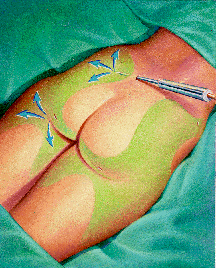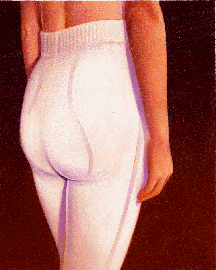Liposuction Toronto Ontario
Liposuction Toronto Ontario:
Liposuction is a procedure that can help sculpt the body by removing unwanted fat from specific areas, including the abdomen, hips, buttocks, thighs, knees, upper arms, chin, cheeks and neck. During the past decade, liposuction, which is also known as "lipoplasty" or "suction lipectomy," has benefited from several new refinements. Today, a number of new techniques, including ultrasound-assisted lipoplasty (UAL), the tumescent technique, and the super-wet technique, are helping many plastic surgeons to provide selected patients with more precise results and quicker recovery times. Although no type of liposuction is a substitute for dieting and exercise, liposuction can remove stubborn areas of fat that don't respond to traditional weight-loss methods.
If you're considering liposuction, this page will give you a basic understanding of the procedure - when it can help, how it is performed and how you might look and feel after surgery. It won't answer all of your questions, since much depends on your individual circumstances. Please ask your doctor if there is anything about the procedure you don't understand.
The best candidates for liposuction
To be a good candidate for liposuction, you must have realistic expectations about what the procedure can do for you. It's important to understand that liposuction can enhance your appearance and self confidence, but it won't necessarily change your looks to match your ideal or cause other people to treat you differently. Before you decide to have surgery, think carefully about your expectations and discuss them with your surgeon.
 |
| Women may have liposuction performed under the chin, on their hips, thighs, and stomach, and in the under arm and breast area. |
The best candidates for liposuction are normal-weight people with firm, elastic skin who have pockets of excess fat in certain areas. You should be physically healthy, psychologically stable and realistic in your expectations. Your age is not a major consideration; however, older patients may have diminished skin elasticity and may not achieve the same results as a younger patient with tighter skin.
Liposuction carries greater risk for individuals with medical problems such as diabetes, significant heart or lung disease, poor blood circulation, or those who have recently had surgery near the area to be contoured.
Planning your surgery
In your initial consultation, your surgeon will evaluate your health, determine where your fat deposits lie and assess the condition of your skin. Your surgeon will explain the body-contouring methods that may be most appropriate for you. For example, if you believe you want liposuction in the abdominal area, you may learn that an abdominoplasty or "tummy tuck" may more effectively meet your goals; or that a combination of traditional liposuction and UAL would be the best choice for you.
Be frank in discussing your expectations with your surgeon. He or she should be equally frank with you, describing the procedure in detail and explaining its risks and limitations.
Getting the answers you need
Individuals considering liposuction often feel a bit overwhelmed by the number of options and techniques being promoted today. However, your plastic surgeon can help. In deciding which is the right treatment approach for you, your doctor will consider effectiveness, safety, cost and appropriateness for your needs. This is called surgical judgement, a skill that is developed through surgical training and experience. Your doctor also uses this judgement to prevent complications; to handle unexpected occurrences during surgery; and to treat complications when they occur.
 |
| For men, common sites include under the chin and around the waist. Liposuction may also be used in the reduction of enlarged male breasts, a condition known as gynecomastia. |
Your surgeon's education and training have helped to form his or her surgical judgement, so take the time to do some background checking. Patients are encouraged to consider a doctor certified by the American Board of Plastic Surgery ("ABPS"). By choosing a plastic surgeon who is certified by the ABPS, a patient can be assured that the doctor has graduated from an accredited medical school and completed at least five years of additional residency - usually three years of general surgery (or its equivalent) and two years of plastic surgery. To be certified by the ABPS, a doctor must also practice surgery for two years and pass comprehensive written and oral exams.
Preparing for your surgery
Your surgeon will give you specific instructions on how to prepare for surgery, including guidelines on eating and drinking, smoking, and taking or avoiding vitamins, iron tablets and certain medications. If you develop a cold or an infection of any kind, especially a skin infection, your surgery may have to be postponed.
Though it is rarely necessary, your doctor may recommend that you have blood drawn ahead of time in case it is needed during surgery.
Also, while you are making preparations, be sure to arrange for someone to drive you home after the procedure and, if needed, to help you at home for a day or two.
Where your surgery will be performed
Liposuction may be performed in a surgeon's office-based facility, in an outpatient surgery center, or in a hospital. Smaller-volume liposuction is usually done on an outpatient basis for reasons of cost and convenience. However, if a large volume of fat will be removed, or if the liposuction is being performed in conjunction with other procedures, a stay in a hospital or overnight nursing facility may be required.
Anesthesia for liposuction
Various types of anesthesia can be used for liposuction procedures. Together, you and your surgeon will select the type of anesthesia that provides the most safe and effective level of comfort for your surgery.
If only a small amount of fat and a limited number of body sites are involved, liposuction can be performed under local anesthesia, which numbs only the affected areas. However, if you prefer, the local is usually used along with intravenous sedation to keep you more relaxed during the procedure. Regional anesthesia can be a good choice for more extensive procedures. One type of regional anesthesia is the epidural block, the same type of anesthesia commonly used in childbirth.
However, some patients prefer general anesthesia, particularly if a large volume of fat is being removed. If this is the case, a nurse anesthetist or anesthesiologist will be called in to make sure you are completely asleep during the procedure.
|
|
||||
|
|
The surgery
The time required to perform liposuction may vary considerably, depending on the size of the area, the amount of fat being removed, the type of anesthesia and the technique used.
There are several liposuction techniques that can be used to improve the ease of the procedure and to enhance outcome.
Liposuction is a procedure in which localized deposits of fat are removed to recontour one or more areas of the body. Through a tiny incision, a narrow tube or cannula is inserted and used to vacuum the fat layer that lies deep beneath the skin. The cannula is pushed then pulled through the fat layer, breaking up the fat cells and suctioning them out. The suction action is provided by a vacuum pump or a large syringe, depending on the surgeon's preference. If many sites are being treated, your surgeon will then move on to the next area, working to keep the incisions as inconspicuous as possible.
Fluid is lost along with the fat, and it's crucial that this fluid be replaced during the procedure to prevent shock. For this reason, patients need to be carefully monitored and receive intravenous fluids during and immediately after surgery.
Technique variations
The basic technique of liposuction, as described above, is used in all patients undergoing this procedure. However, as the procedure has been developed and refined, several variations have been introduced.
Fluid Injection, a technique in which a medicated solution is injected into fatty areas before the fat is removed, is commonly used by plastic surgeons today. The fluid - a mixture of intravenous salt solution, lidocaine (a local anesthetic) and epinephrine (a drug that contracts blood vessels) - helps the fat be removed more easily, reduces blood loss and provides anesthesia during and after surgery. Fluid injection also helps to reduce the amount of bruising after surgery.
The amount of fluid that is injected varies depending on the preference of the surgeon.
Large volumes of fluid - sometimes as much as three times the amount of fat to be removed - are injected in the tumescent technique. Tumescent liposuction, typically performed on patients who need only a local anesthetic, usually takes significantly longer than traditional liposuction (sometimes as long as 4 to 5 hours). However, because the injected fluid contains an adequate amount of anesthetic, additional anesthesia may not be necessary. The name of this technique refers to the swollen and firm or "tumesced" state of the fatty tissues when they are filled with solution.
The super-wet techniqueis similar to the tumescent technique, except that lesser amounts of fluid are used. Usually the amount of fluid injected is equal to the amount of fat to be removed. This technique often requires IV sedation or general anesthesia and typically takes one to two hours of surgery time.
Ultrasound-Assisted Lipoplasty (UAL). This technique requires the use of a special cannula that produces ultrasonic energy. As it passes through the areas of fat, the energy explodes the walls of the fat cells, liquefying the fat. The fat is then removed with the traditional liposuction technique.
UAL has been shown to improve the ease and effectiveness of liposuction in fibrous areas of the body, such as the upper back or the enlarged male breast. It is also commonly used in secondary procedures, when enhanced precision is needed. In general, UAL takes longer to perform than traditional liposuction.
All surgery carries some uncertainty and risk
Liposuction is normally safe, as long as patients are carefully selected, the operating facility is properly equipped and the physician is adequately trained.
As a minimum, your surgeon should have basic (core) accredited surgical training with special training in body contouring. Also, even though many body-contouring procedures are performed outside the hospital setting, be certain that your surgeon has been granted privileges to perform liposuction at an accredited hospital.
Your doctor must have advanced surgical skills to perform procedures that involve the removal of a large amount of fat (more than 5 liters or 5,000 ccs); ask your doctor about his or her other patients who have had similar procedures and what their results were. Also, more extensive liposuction procedures require attentive after-care. Find out how your surgeon plans to monitor your condition closely after the procedure.
However, it's important to keep in mind that even though a well-trained surgeon and a state-of-the art facility can improve your chance of having a good result, there are no guarantees. Though they are rare, complications can and do occur. Risks increase if a greater number of areas are treated at the same time, or if the operative sites are larger in size. Removal of a large amount of fat and fluid may require longer operating times than may be required for smaller operations.
The combination of these factors can create greater hazards for infection; delays in healing; the formation of fat clots or blood clots, which may migrate to the lungs and cause death; excessive fluid loss, which can lead to shock or fluid accumulation that must be drained; friction burns or other damage to the skin or nerves or perforation injury to the vital organs; and unfavorable drug reactions.
There are also points to consider with the newer techniques. For example, in UAL, the heat from the ultrasound device used to liquefy the fat cells may cause injury to the skin or deeper tissues. Also, you should be aware that even though UAL has been performed successfully on several thousand people worldwide, the long-term effects of ultrasound energy on the body are not yet known.
In the tumescent and super-wet techniques, the anesthetic fluid that is injected may cause lidocaine toxicity (if the solution's lidocaine content is too high), or the collection of fluid in the lungs (if too much fluid is administered).
The scars from liposuction are small and strategically placed to be hidden from view. However, imperfections in the final appearance are not uncommon after lipoplasty. The skin surface may be irregular, asymmetric or even "baggy," especially in the older patient. Numbness and pigmentation changes may occur. Sometimes, additional surgery may be recommended.
After your surgery
 |
| Improvement will become apparent after about six weeks, when most of the swelling has subsided. |
After surgery, you will likely experience some fluid drainage from the incisions. Occasionally, a small drainage tube may be inserted beneath the skin for a couple of days to prevent fluid build-up. To control swelling and to help your skin better fit its new contours, you may be fitted with a snug elastic garment to wear over the treated area for a few weeks. Your doctor may also prescribe antibiotics to prevent infection.
Don't expect to look or feel great right after surgery. Even though the newer techniques are believed to reduce some post-operative discomforts, you may still experience some pain, burning, swelling, bleeding and temporary numbness. Pain can be controlled with medications prescribed by your surgeon, though you may still feel stiff and sore for a few days.
It is normal to feel a bit anxious or depressed in the days or weeks following surgery. However, this feeling will subside as you begin to look and feel better.
Getting back to normal
Healing is a gradual process. Your surgeon will probably tell you to start walking around as soon as possible to reduce swelling and to help prevent blood clots from forming in your legs. You will begin to feel better after about a week or two and you should be back at work within a few days following your surgery. The stitches are removed or dissolve on their own within the first week to 10 days.
Activity that is more strenuous should be avoided for about a month as your body continues to heal. Although most of the bruising and swelling usually disappears within three weeks, some swelling may remain for six months or more.
Your surgeon will schedule follow-up visits to monitor your progress and to see if any additional procedures are needed.
If you have any unusual symptoms between visits - for example, heavy bleeding or a sudden increase in pain - or any questions about what you can and can't do, call your doctor.
Your new look
You will see a noticeable difference in the shape of your body quite soon after surgery. However, improvement will become even more apparent after about four to six weeks, when most of the swelling has subsided. After about three months, any persistent mild swelling usually disappears and the final contour will be visible.
If your expectations are realistic, you will probably be very pleased with the results of your surgery. You may find that you are more comfortable in a wide variety of clothes and more at ease with your body. And, by eating a healthy diet and getting regular exercise, you can help to maintain your new shape.
|
|
Frequently Asked Questions About
Liposuction
Dr. Jerome Edelstein, MD, FRCSC
Plastic Surgeon
Introduction
Liposuction is a surgical procedure designed to improve body shape and contour by removing fatty deposits. It is the most common plastic surgery procedure done in North America. In women, the most common areas treated are the waist, hips, and thighs. Men most commonly want their abdomen treated (the Ďspare-tireí). Other areas that can be treated include the knee region, calves, upper arms, and chin. Some cases of excess breast development in men can be treated as well.
Liposuction should not be considered a substitute for weight reduction. The best results are seen in people with average body weights and firm skin tone who canít get rid of fatty deposits despite diet and exercise. The reality is that certain areas of fat are resistant to diet and exercise - this is where liposuction can help.
What type of anesthesia is used during the operation?
This procedure is usually performed under General Anesthesia. Small areas can occasionally be done under Local Anesthesia with sedation to help you relax. An Anesthetist is always present. If you have any particular problems with anesthesia, please let us know.
How long is the operation?
This very much depends on the number of areas that are going to be treated, and whether liposuction is going to be combined with other procedures such as a tummy-tuck. The duration varies between 1 and 6 hours.
Where are the incisions made?
The incisions are very small, no more than 1 centimeter, placed inconspicuously in a natural skin fold or crease adjacent to the area being treated.
What else is done during the procedure?
A thin, long, hollow tube, called a cannula, is inserted under the skin through the small incision. First, a salt water and anesthetic solution is injected - this is called tumescent liposuction. If ultrasonic liposuction is also used, an ultrasound probe is then inserted into the fat. Vibration of the probe liquefies the fat. Finally, a high pressure suction machine removes the fat as the cannula is moved back and forth underneath the skin. Tumescent and Ultrasonic Liposuction are the state of the art in this type of surgery. They help to reduce bruising and swelling, and to speed recovery.
How long is the hospital stay?
Liposuction is usually an outpatient procedure, meaning you can go home the same day once you have recovered from the anesthetic. If very large areas are going to be treated, you may have to stay overnight and go home the day after surgery.
When are the stitches removed?
Stitches are removed between 7-10 days. Sometimes dissolving stitches are used that donít have to be removed.
What happens after the surgery?
Most people feel tender and bruised after surgery, but are not in a great deal of pain. Pain medication will make you comfortable.
You should plan to be off work for 4-7 days. During that time you are encouraged to go for leisurely walks. Athletic activities usually have to wait until approximately 2-3 weeks.
A support garment is worn for 6 weeks - night and day for the first three weeks, and then during the day for another three weeks. This garment will help reduce swelling and conform the skin to your new shape. Showering is permitted on the 3írd day after surgery. Massage of the treated areas will begin 7-10 days after surgery to help decrease the swelling faster and to smooth out any irregularities. Scars will initially be red and a little raised, but over 3-6 months they usually get lighter in colour and flatten out.
What are the results?
Good improvement in your shape can be predictably achieved. The scars are usually well hidden. Most patients are very happy with their results.
Is liposuction permanent?
The procedure re-contours the body by reducing the number of fat cells. This is permanent. If one does gain a significant amount of weight, the fat cells that do remain can enlarge diminishing the benefits. Overall contour, however, remains improved.
Some additional points:
Make sure you let me know your complete medical history as well as any medications, drugs, vitamins, or natural herbs you are taking. For example, diabetes is known to affect wound healing.
Smoking also affects your ability to heal, and I recommend that you stop smoking at least 2 weeks before
surgery. Aspirin, anti-inflammatory pills (like anaprox or motrin), and vitamin E also should be stopped 2 weeks before surgery because they can cause extra bleeding.
I strive to make sure all my patients are well informed. Your questions are more than welcome.

This symbol designates surgeons who are active members of the American Society of Plastic Surgeons. They are certified in the specialty of plastic surgery by the American Board of Plastic Surgery and are dedicated to the highest standards of patient welfare and surgical excellence.





